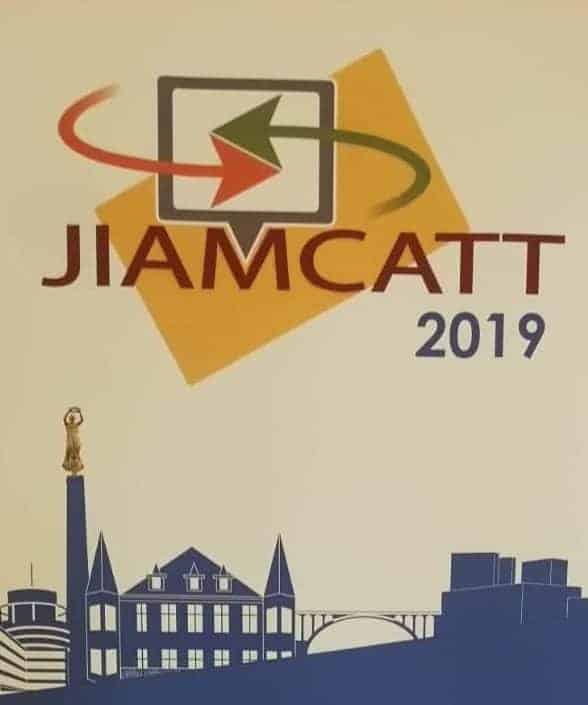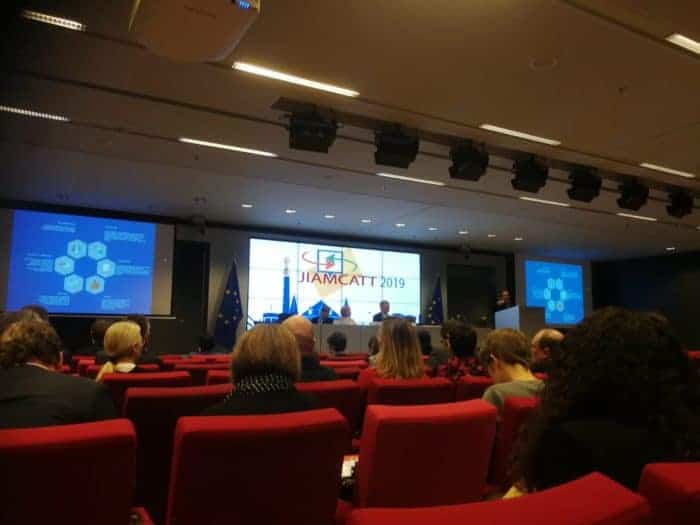
Introduction
From the 13th to the 15th of May, the European Convention Centre in Luxembourg hosted the JIAMCATT, the International Annual Meeting on Computer-Assisted Translation and Terminology. The topic of this year was “the Shape of Things to Come: How technology and innovation are transforming the language professions”.
This huge event, now particularly crucial because of the recent astonishing quality improvements of Neural Machine Translation, saw the participation of representatives from industry, academia, in-house developers of NMT and SMT (‘S’ for statistical) as well as vendors of some of the biggest CAT tools on the market.
Obviously, TermCoord could not miss this chance, given the particular focus on terminology and the multiple scenarios regarding its interpolation with the NMT.
This kind of events is always extremely important, not only because they keep us connected to whom have the finger on the pulse, but also because we (the main users of these technologies) can explain our needs, doubts, wishes, and daily-routine issues.
Progress
The topics discussed in these three days have been the integration of terminology in machine translation, the future of the translator’ s profession, the role of translators, terminologists and revisers; the costly process of human revision and the possibility of automated revision; even what part of the translation process should be automated (or not), the language or the workflow. All of which had been changed and/or automated by other actors in the industry by means of AI.
The conference’s days were mostly divided in two parts: the morning for presentations and the afternoon for workshops, where it was possible to meet the speakers.
In “Bringing terminology to IATE users” Paula Zorrilla-Agut, from the Translation Centre for the Bodies of the EU, offered a more detailed overview on the enhanced search capabilities in the new IATE (full text search, enriched filtering, advanced query builder, public search APIs, advanced language processing via the redeveloped term recognition module) and the options to exploit results according to different needs (enriched results page, flexible full entry view, tabular exports, CAT-compatible exports and other).
In “Controlled vocabularies and terminology assets for the semantic web” Denis Dechandon and Aniko Gerenscer from the Publications Office of the EU offered many insights about the role of metadata and the advantages of an enhanced interoperability. According to their work simple lists of terms, glossaries and taxonomies should be linked to relevant ontologies. The next step consists in making them accessible, shared and managed in a collaborative manner. As they are being increasingly used to drive data, content and information processes, the time has come to build networks of multilingual and cross-domain terminologies and to go for a systematic integration of semantics and metadata.
A member of the United Nations staff, Frances Enriquez, talked about the latest developments in the UN-developed language tools, including eLUNa Translation/Revision, eLUNa Editorial, eLUNa for Verbatim Reporters, and UNTERM.
Grzegorz Okoniewski from the European Commission’s DG Translation (DGT) showed the IT-supported quality assurance tool used at DGT, where it was developed internally for error detection during and after translation process. It is regex-based and executed in the QA Checker in SDL Studio. He also introduced a beta-version of a regex-conversion tool, converting bilingual term lists to valid regex strings.

Conclusions
The breakthrough of NMT has plainly enlivened the translation world, but it is not a secret that many translators fear to become “redundant” in the following years. This legitimate apprehension has triggered also a feeling of scepticism especially among the most experienced translators.
The significant decrease of active translation in their workflow has to be taken as a positive aspect, which in turn can encourage the birth of new roles such as the revisor, the multilingual knowledge manager (committed to terminology, taxonomy, domain classifications and interoperability insurance), the linguistic assets curator (who trains NMT, selects documents for recycling, updates and deletes data), and the translation workflow engineer (who balances time, cost,quality, customize nlp components, defines quality criteria, provides audit trails) as duly pointed out by Jochen Hummel, founder of TRADOS.
Joke Daems, researcher at the University of Ghent, has demonstrated moreover that texts/translations produced by the machine are in many cases revised by a human reviser whose psychology has turned out to play an important role. As ‘we want the machine to be bad’, we revise its text more but if we believe that the text to be revised was produced by a professional translator instead, we revise and judge it differently. Does the fact that revisers corrected less when they thought it was a human translation, allow us not to disclose the origin of the translation?
Follow up
Inspired by JIAMCATT 2019 conclusions, the Head of the Terminology Coordination Unit Rodolfo Maslias, wrote the article ‘Terminology in the Brain of the Machine’ in which he sketches some strategies for TermCoord in order to contribute to the integration of terminology in the European machine translation and, in general, to react promptly to the new changes.
The area of interest is still evolving but JIAMCATT 2019 did give us an idea of how the biggest actors of the market handle this challenge and of how we should handle it ourselves. The JIAMCATT 2020 will surely address these issues even more exhaustively.
How such a revolution will look like, only time will show. But the future is definitely here and we cannot stop it!
Click here to download the official “Conclusions & Recommendation” of JIAMCATT 2019.
Written by Cosimo Palma, Communication Trainee at the Terminology Coordination Unit of the European Parliament (Luxembourg), and Stine Jensen, Terminologist at the Terminology Coordination Unit in the European Parliament (Luxembourg).


